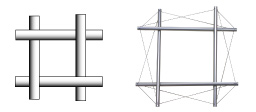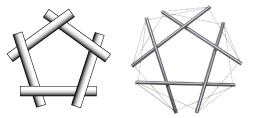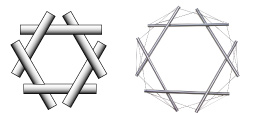|
|
|||||
| Weaving and tensegrity share the same grounding principle of alternating helical directions; of left to right; of bypasses clockwise and counterclockwise. In these figures, the column on the left shows the primary weave cells.
To their right are the equivalent basic tensegrity modules. By transposing each weave filament to become a strut (stick, tube or rod) the cells transform into arrays of two, three, four, etc. compression members. They retain their original form and helical direction. Individual tension lines (strings, wires or rope) are attached to the ends of the struts as shown so that each assembly comprises a closed system of tension and compression parts. Each tension line connects individually to the ends of two struts; they do not thread through like strings of beads. The lines are made taut so that they bind the struts, pressing on them as a continuous tension network. The forces introduced by the tightening is permanently stored in the structure, a state known as prestressing. In tensegrity structures complete triangulation in the tension network is highly important for it decides whether the structure is firm or flaccid. Only the cross with its two struts (and four tension members) and the three-way prism among these primitive figures have total triangulation. The square, the pentagon and the hexagon do not. They can be stabilized with additional lines but the supplimental lines necessarily will be selective in directions that will distort the form. The transformed weave cell has now become an endoskeletal structure, mammal-like in that its muscles are external to the bones. Uniquely in tensegrity, the compression struts are separated one from another; non-touching within their tension envelope. The exception is the two-strut cross unit which lacks forces in the “Z” direction needed to separate the two struts. The cross figure is the same as a common kite frame in which the two sticks press on one another at their intersection. This simple form known as an “X” module, is the preeminent key to all extended tensegrity structures. |

X-module; complete triangulation
3-way prism; complete triangulation
square prism; squares are non-triangulated
pentagonal prism; pentagons are non-triangulated
hexagonal prism; hexagons are non-triangulated |
||||



